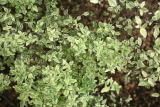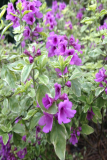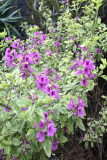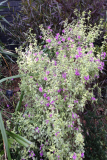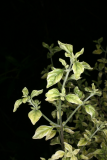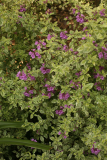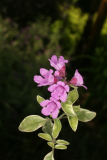Additional notes (click to expand)
Horticulture
Bushy shrub with erect stems and lance-shaped to inversely lance-shaped, entire, matt, grey-green leaves, to 1.5cm long. In late spring and early summer, an abundance of cup-shaped purple flowers, 1cm across, are borne in leafy, terminal racemes, 6-7cm long. 2.5m high by 1.5m wide
Brickell, C. (2003). A-Z Encyclopedia of Garden Plants. Dorling Kindersley. p.854
To cultivate: under glass, grow in a loam-based potting compost (J.I. No 2) in full light. When in growth, water moderately and apply a balanced liquid fertiliser monthly; water sparingly in winter. Outdoors, growth in moderately fertile, moist but well-drained soil in full sun. Prune lightly to keep the shape after flowering. Hard pruning could be detrimental.
To propagate, take semi-ripe cuttings in summer.
Prone to red spider mite and whitefly if grown under glass.
Brickell, C. (2003). A-Z Encyclopedia of Garden Plants. Dorling Kindersley. p.854
Medicinal
Another species of Prostanthera, P. rotundifolia, is rich in volatile oils, including menthol and cineole (as found in the mints, Mentha species). They are used externally in the treatment of colds and headaches. Presumably the leaves are infused in a bowl of hot water and the vapour inhaled.
Plants for a Future at www.plantsforafuture.org.uk http://www.pfaf.org/user/Plant.aspx?LatinName=Prostanthera+rotundifolia
link
Nomenclature
Prostanthe’ra- Greek for prostithemi, to append or add to, prosthema, appendage; anthera, anther; in an allusion to a spur-like appendage on the back of the anther.
Stearn, W.T. (1996). Dictionary of Plant Names for Gardeners. Cassell. p.249
ovalifolia- oval, broadly elliptic foliage
Other use
An essential oil can be extracted from crushing the leaves of the species, Porstanthera rotundifolia. The leaves yield up to 0.7% of the oil. The dried leaves are also used in pot-pourri.
Plants for a Future at www.plantsforafuture.org.uk http://www.pfaf.org/user/Plant.aspx?LatinName=Prostanthera+rotundifolia
link
Phytochemistry
Probably 1,8-cineole which is the main component of the volatile oil.
Lassak, E.V., McCarthy, T.. (2001). Australian Medicinal Plants . J B Books/Reed New Holland, Australia. p.160
Prostanthera ovalifolia R. Br. 'Variegata'
Family: LAMIACEAEGenus: Prostanthera
Species: ovalifolia R. Br.
Cultivar: 'Variegata'
Common names: Thousand Flowered Mint-Bush; Purple Mint-Bush 'Variegata'
Distribution summary: E.Australia
Habit: Shrub
Hardiness: H4 - Hardy; average winter
Habitat: Garden origin
Garden status: Not currently grown
Flowering months: May
Reason for growing: Medicinal
